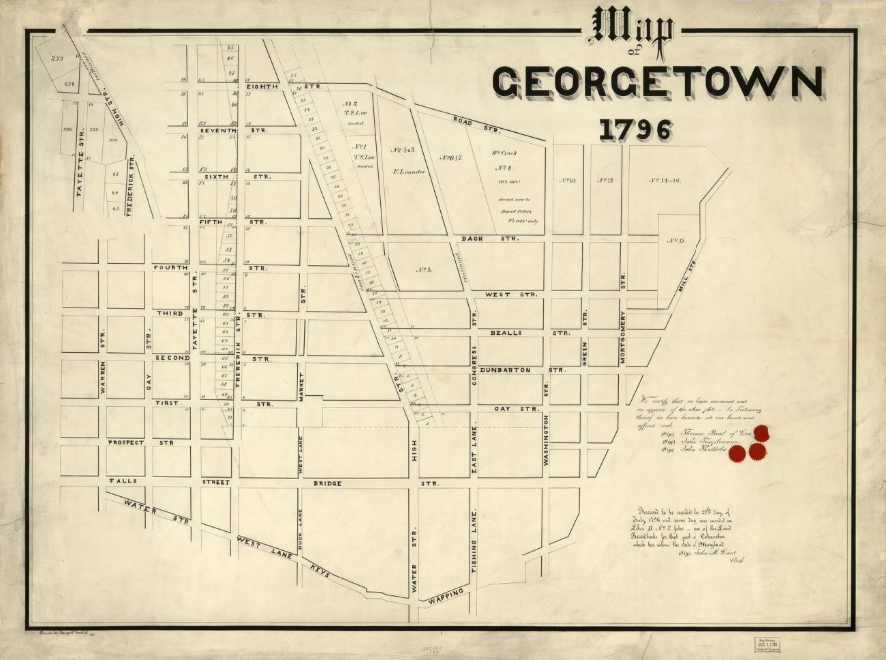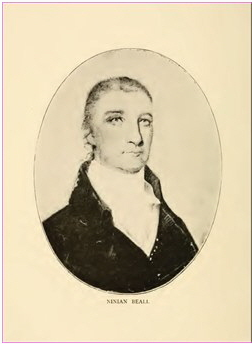A Brief History of Georgetown

Early History
Georgetown has a varied history of successful industries and residents – Freedmen, presidents, dignitaries, and socialites, as well as Native Americans and slaves – from its founding as a tobacco inspection port to its days in the mid 20th century filled with slums to present day.
More than 400 hundred years ago, the Algonquin Indian Nation settled in the area well before the first visit by Capt. James Cook in 1618. Prior to those documented settlements, there is mounting evidence from archaeological remains that Washington DC and Georgetown may have been home to Paleoindians from as far back as 12,000 years ago.
Read here for more history of that early time period.
Before the arrival of Europeans, The Anacostian tribe lived here, along the Potomac River near Rock Creek. Captain John Smith was one of the first to record the landscape and these native American inhabitants. According to Thomas Jefferson, the Georgetown locale became a central meeting place for nearly 40 Indian Tribes. Colonization was inevitable as the fertile soil, climate, and river provided the most ideal conditions for settlement of the New World. Many Scottish and German immigrants traveled here to claim as their new home.

Colonial Times
Founded in 1751, Georgetown’s original boundaries only extended north from the river a few blocks to Gay Street, now N Street. The western and eastern boundaries have remained the same. The first grant of land went to Col. Ninian Beall. (Who had quite the storied history of his own). The second original landowner of Georgetown was George Gordon. Most of the original European landowners in Georgetown were Scottish. There seems to be no historical consensus regarding which George the town was named. It may have been to honor King George II of England or could have been named after one of the first two European residents both, named George. Once the government was looking for a new place to settle after the Revolutionary War, Georgetown was an ideal pick. It has an established community with taverns and boarding houses and a river that could support and help grow trade in the region.
When it became time for President George Washington to select a site for the new United States capital, he advocated for a place close to his estate in Mt. Vernon. In 1791 George Washington included Georgetown in the new Federal City plan to be built across Rock Creek and occupied by the new government in 1800. By 1860, a merger of the City of Washington and Georgetown was considered, but the Civil War disrupted those plans. Plans were finally settled in 1871 when it was decided that DC would include Georgetown and that Georgetown would become a territory, overseen by the US Congress.
Commerce in the 1800’s
As the tobacco industry continued to prosper, so did the residential community. Like most of the cities of the time, Georgetown was built with slave labor. At the time of the abolishment of slavery, in 1862, Georgetown had a sizeable Black American population of both slaves and freemen. The NW corner of Georgetown became an established community of freedmen with its own shops, lawyers, and schools. The tobacco industry continued to grow until the Potomac river no longer became viable for river trade. A creative solution was found in the Chesapeake & Ohio Canal. The Canal become an important part of the city with families moving to live along the waterfront. Between better railroad passage and the opening of the Q St. Bridge, the canal become less useful. Today the Canal is a historic park with recreational trails and has become one of the iconic features of Georgetown’s landscape.
20th Century Georgetown
World War II brought new residents to GT and DC, which helped transform GT into a more sophisticated city. Commercial development had taken hold at the waterfront. During expansion, the Old Georgetown Act of 1950 was passed to keep the commercial development from consuming its historic neighborhoods. By 1967, GT was declared a National Historic Landmark. Its 18th and 19th charms have been preserved in its architecture, streets, homes, and businesses.
To learn more about Georgetown History, check out the Georgetown Peabody Library
You won’t be disappointed.
